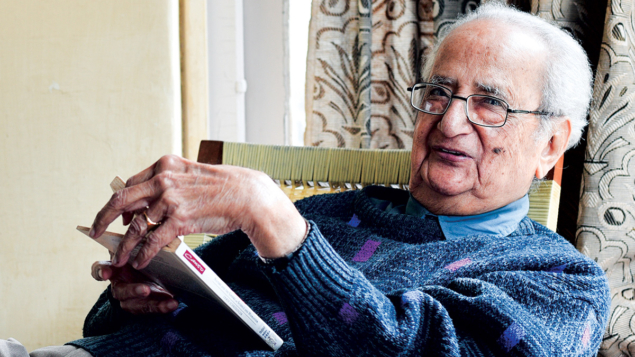
Badanaval Venkatasubba Sreekantan, a pioneering cosmic-ray physicist and a member of Homi Bhabha’s team of scientists, who played an important role in the development of post-colonial Indian science, died at his home in Bangalore on 27 October 2019.
Sreekantan was born on 30 June 1925 near Mysore in South India. After receiving his master’s degree in physics in 1947 with a specialisation in wireless technology from Mysore University, he joined the Indian Institute of Science at Bengaluru as a research scholar, where he heard about Bhabha and his newly formed Tata Institute of Fundamental Research (TIFR) in Mumbai. Attracted by Bhabha’s charisma, he joined TIFR in July 1948 and began a long, illustrious scientific career of almost 44 years.
In 1951 Bhabha sent Sreekantan down the deep Champion Reef Gold Mine at Kolar Gold Fields (KGF) near Bengaluru to measure the flux of cosmic-ray muons at varying depths. This pioneering initiative not only earned Sreekantan a PhD but also paved the way for setting up a deep underground laboratory. A series of follow-up experiments at KGF, carried out during the early 1960s, extended his previous measurements of muon intensity to the deepest level available; finally, after reaching a depth of 2700 m, recording no muons after two months of exposure. Sreekantan and his collaborators realised that such a deep underground site with minimal cosmic-ray muon background would be an ideal site to detect atmospheric neutrinos. A series of seven neutrino telescopes were quickly set up at a depth of 2300 m and in early 1965 they recorded the first atmospheric-neutrino event, contemporaneously with the detection from another underground neutrino experiment set up by Fred Reines in a South African mine. It was an important milestone, given how important the study of neutrinos underground would later become.
During early 1980s Sreekantan and his collaborators built two detectors, one at a depth of 2300 m and the other at 2000 m, to study the stability of the proton. These two experiments ran for more than a decade and put strong limits on the proton lifetime. He was also instrumental in starting a high-altitude cosmic-ray laboratory at Udhagamandalam (Ooty) in the State of Tamil Nadu to study the hadronic components of cosmic-ray showers.
Sreekantan quickly recognised the importance of the emerging field of X-ray astronomy for probing high-energy processes in the universe. In 1967 he started balloon-borne experiments to study cosmic X-ray sources and built a strong group that went on to develop expertise in the fabrication of highly sophisticated X-ray detectors for space-borne astronomy missions. The multi-wavelength astronomy observatory Astrosat, launched by the Indian Space Research Organisation in September 2015, is a testimony to the strength of the group. A very high-energy gamma-ray observation programme using the atmospheric Cherenkov technique, which was started by Sreekantan and his collaborators in Ooty in the 1970s, is being continued in Ladakh with a low-energy threshold.
Sreekantan became director of TIFR in 1975, and over the next 12 years steered the institute with distinction and left a rich legacy of high-quality research programmes as well as several new TIFR centres and field stations. In 1992, after a long and eventful scientific carrier at TIFR, Sreekantan moved to Bengaluru and was offered a chair at the newly created National Institute of Advance Studies. His research interest shifted from physical sciences to the philosophical aspects of science and in particular to the abstract topic of consciousness and its scientific and philosophical basis. He remained an alert and active researcher and was engaged in his academic activities with great eagerness until the very end. His death marks the end of a glorious chapter of experimental cosmic-ray research in India.





